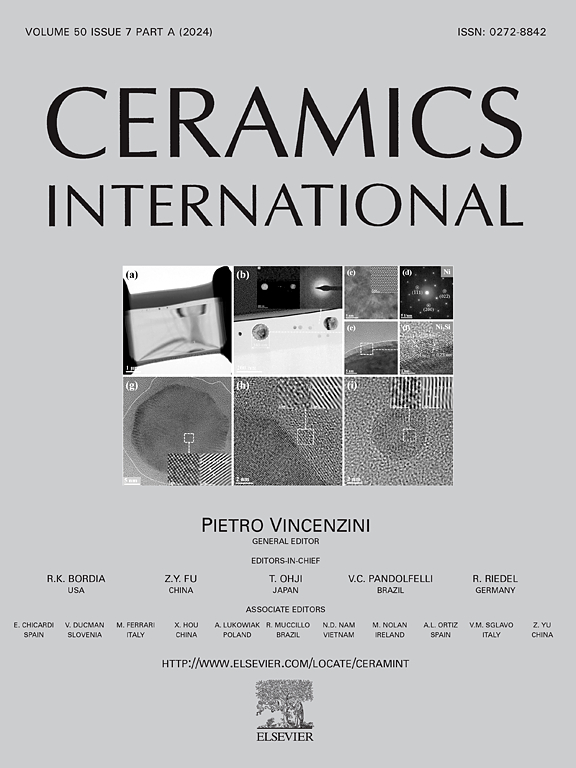掺杂SnS2诱导氨敏感传感器的s -空位
IF 5.6
2区 材料科学
Q1 MATERIALS SCIENCE, CERAMICS
引用次数: 0
摘要
本研究采用一步水热法合成了掺杂SnS2纳米结构。表征结果表明,合成材料中成功地构建了S空位。制备了掺杂不同质量铟的样品。其中,中等硫空位含量的In/Vs2-SnS2样品在室温下的氨检测响应最佳(500 ppm),峰值响应达到2392。传感器的响应/恢复时间为37.5s/3.3s。用第一性原理DFT计算确定了氨在纯SnS2相表面和S空位样品上的吸附能。理论分析与实验结果吻合较好,表明S空位为有效吸附提供了更多的活性位点,有利于氨分子的灵敏检测。本研究表明,in掺杂在SnS2中产生了S空位,有望用于气敏化,为高性能室温气体传感器奠定基础。本文章由计算机程序翻译,如有差异,请以英文原文为准。
In-doped SnS2 induced S-vacancies for ammonia-sensitive sensors
In this study, In-doped SnS2 nanostructures were synthesized by a one-step hydrothermal method. Characterization results demonstrated that S vacancies were successfully constructed in the synthesized material. Samples doped with different masses of indium were prepared. Among them, the In/Vs2-SnS2 sample with moderate sulfur vacancy content showed the best ammonia detection response (500 ppm) at room temperature, and the peak response reached 2392. Moreover, the sensor exhibited a response/recovery time of 37.5s/3.3s. The adsorption energies of ammonia on the pure phase SnS2 surface and S vacancies sample were determined by the first principle DFT calculations. The theoretical analysis agreed well with the experimental results, suggesting that the S vacancies provided more active sites for effective adsorption, favoring the sensitive detection of ammonia molecules. The proposed study demonstrates that In-doping created S vacancies in SnS2, which is promising for gas sensitization, laying the foundation for high-performance room-temperature gas sensors.
求助全文
通过发布文献求助,成功后即可免费获取论文全文。
去求助
来源期刊

Ceramics International
工程技术-材料科学:硅酸盐
CiteScore
9.40
自引率
15.40%
发文量
4558
审稿时长
25 days
期刊介绍:
Ceramics International covers the science of advanced ceramic materials. The journal encourages contributions that demonstrate how an understanding of the basic chemical and physical phenomena may direct materials design and stimulate ideas for new or improved processing techniques, in order to obtain materials with desired structural features and properties.
Ceramics International covers oxide and non-oxide ceramics, functional glasses, glass ceramics, amorphous inorganic non-metallic materials (and their combinations with metal and organic materials), in the form of particulates, dense or porous bodies, thin/thick films and laminated, graded and composite structures. Process related topics such as ceramic-ceramic joints or joining ceramics with dissimilar materials, as well as surface finishing and conditioning are also covered. Besides traditional processing techniques, manufacturing routes of interest include innovative procedures benefiting from externally applied stresses, electromagnetic fields and energetic beams, as well as top-down and self-assembly nanotechnology approaches. In addition, the journal welcomes submissions on bio-inspired and bio-enabled materials designs, experimentally validated multi scale modelling and simulation for materials design, and the use of the most advanced chemical and physical characterization techniques of structure, properties and behaviour.
Technologically relevant low-dimensional systems are a particular focus of Ceramics International. These include 0, 1 and 2-D nanomaterials (also covering CNTs, graphene and related materials, and diamond-like carbons), their nanocomposites, as well as nano-hybrids and hierarchical multifunctional nanostructures that might integrate molecular, biological and electronic components.
 求助内容:
求助内容: 应助结果提醒方式:
应助结果提醒方式:


